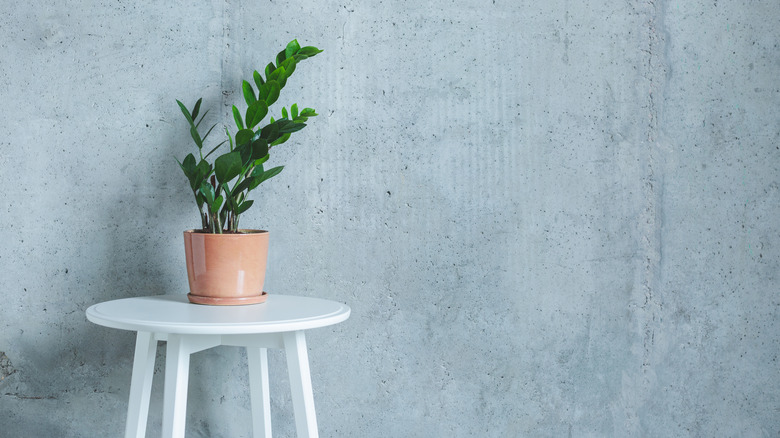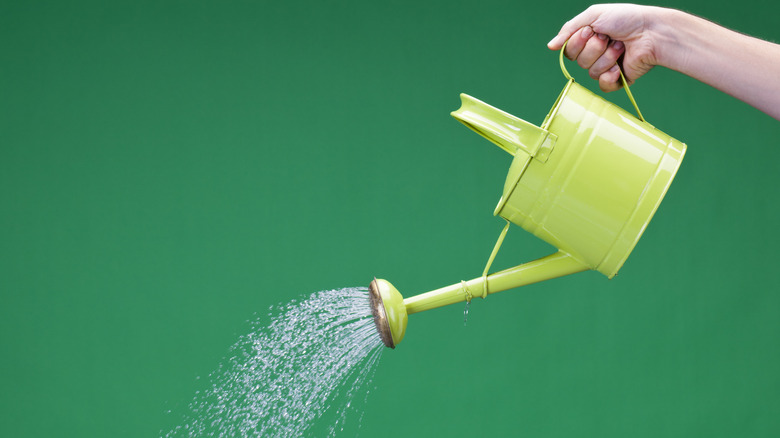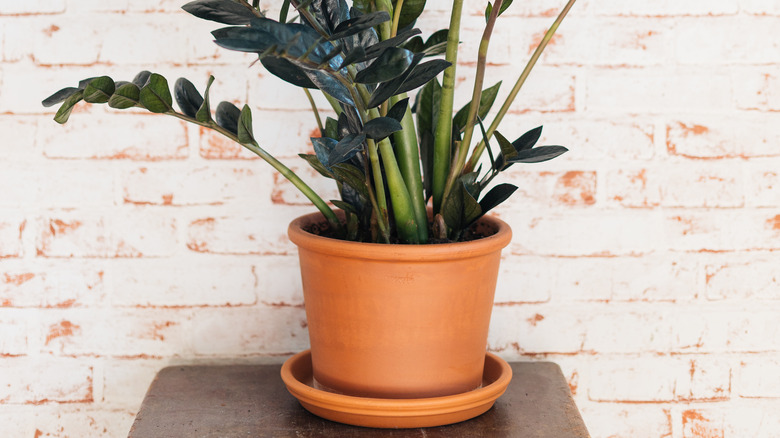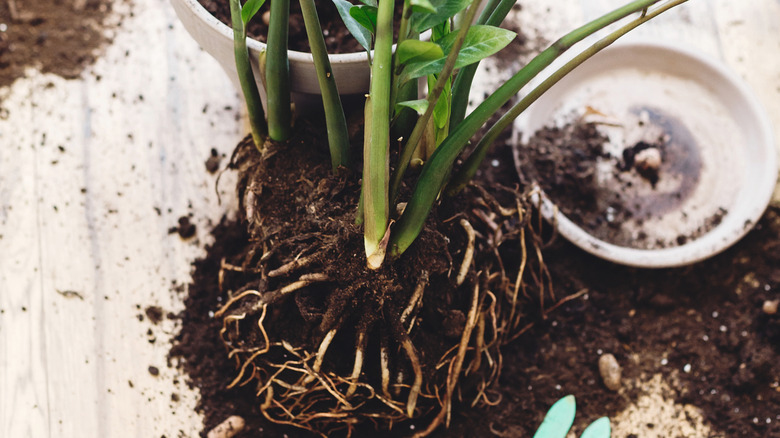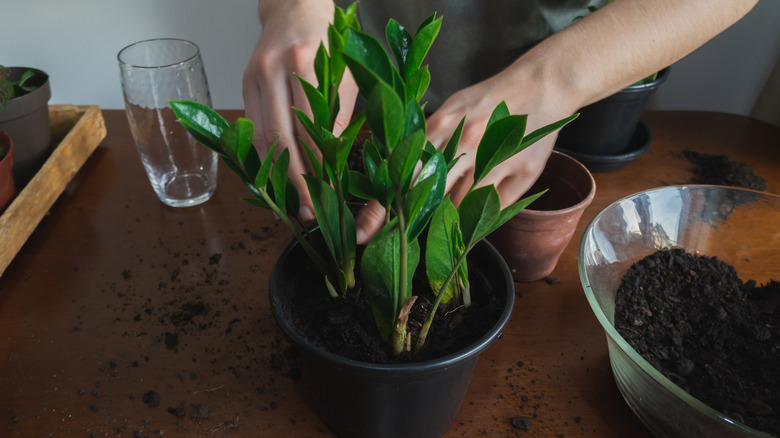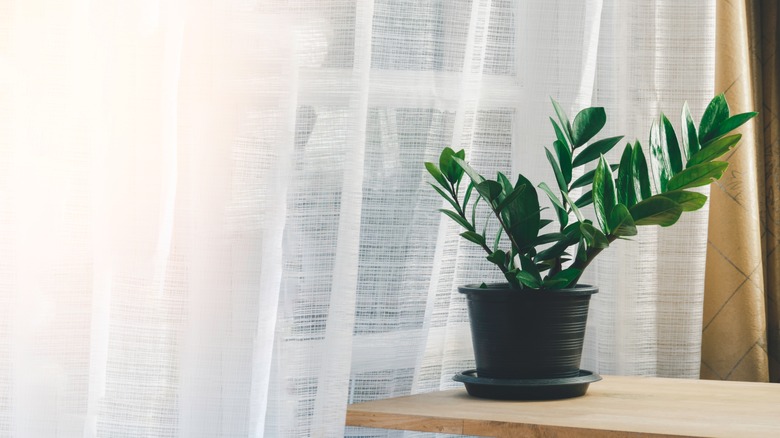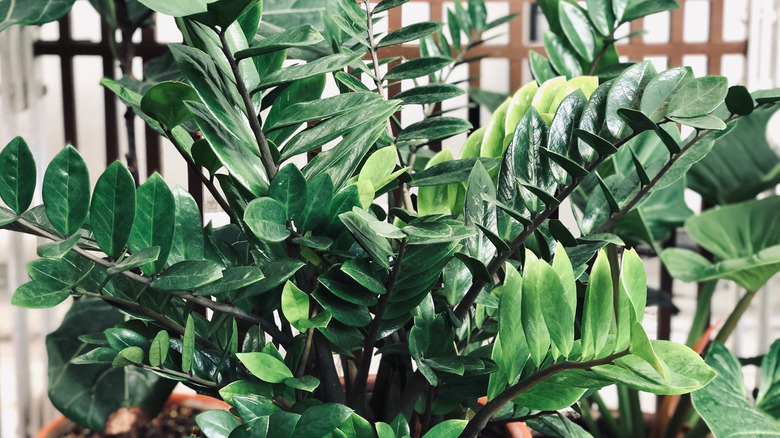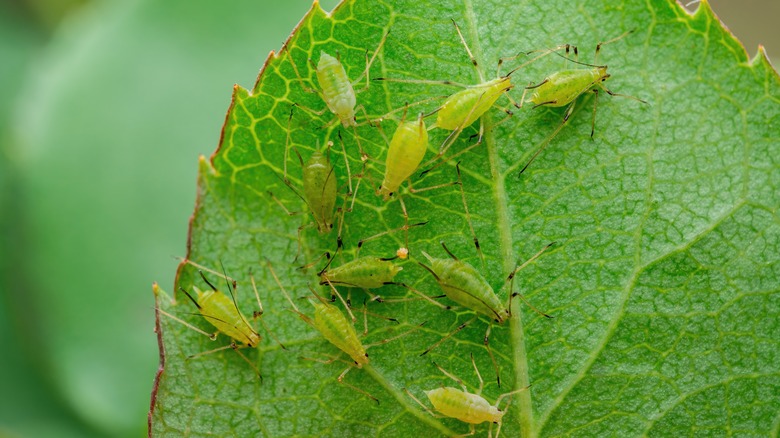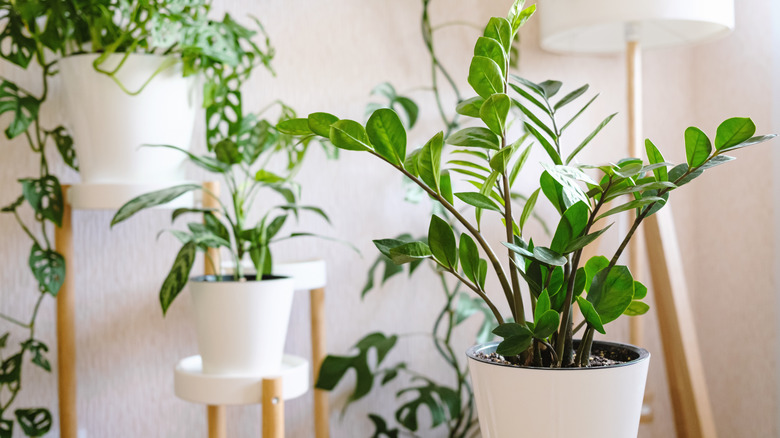Surefire Ways To Bring Your Dying ZZ Plant Back To Life
With a binomial name like Zamioculcas zamiifolia, it's no wonder the ZZ plant goes by its simple nickname. This houseplant is easy to care for, but you should be aware of negative issues that might develop. If you think your plant is dying, you can bring it back to life by making a few positive adjustments to ensure that it gets appropriate water, light, nutrients, and room to grow.
This very forgiving plant adapts to indoor conditions and even tolerates occasional neglect from its owner. In fact, the ZZ plant suffers more when you give it too much water rather than too little, and when it gets too much direct sunlight rather than not enough. But despite its adaptability, you can still kill a ZZ by making mistakes in its care or by placing it in a negative growing environment. Fortunately, you can take proactive steps to correct the mistakes and return a dying plant to good health.
Adjust your watering schedule
The most common watering mistake that ZZ plant owners make is overwatering, rather than under-watering. This plant thrives when the soil dries out between waterings, which is due to its natural drought tolerance, a result of adaptation to its native habitat in eastern Africa (via University of Florida). If you're watering your ZZ plant more than once every week or two, the soil may not dry out enough for the plant to thrive. In fact, a common killer for ZZ plants is root rot, a condition that develops when the soil remains wet. When you see that the leaves of your ZZ plant are turning yellow or brown, it may be a sign of rotting roots caused by overwatering.
To save your ZZ from root rot, remove the plant from its pot to begin treatment. Gently brush the soil from the rhizomes and use a pair of sterilized scissors to cut away any dark, squishy material. Spray the remaining rhizomes with a mixture of two parts water and one part 3% hydrogen peroxide. This should kill any rot-producing bacteria that remains. Then, repot the plant in fresh soil and move forward with a less-frequent watering schedule. In low light and winter months, you can water the plant every two to three weeks. During warm months and in brighter light, you can adjust the watering schedule to once every seven to 14 days.
Move it to a pot with better drainage
Although your ZZ plant is happiest when the soil dries out between waterings, a pot with poor drainage hampers the drying process and may eventually kill the plant. If you suspect your pot is not draining adequately, it's time to move the plant to a container that provides a healthier environment by allowing water to drain away from the plant's roots.
Be sure to plant your ZZ in a container with one or more drainage holes in the bottom. If it's made of a porous material like wood, clay, or terra cotta, one central hole should be enough. On the other hand, you'll need more than one drainage hole in the bottom of pots made from non-porous materials, such as glazed pottery, glass, metal, and plastic. Three drainage holes are desirable for pots larger than 6 inches in diameter. These should be spaced evenly on the bottom of the pot to ensure that the water drains uniformly throughout the soil. When you water your ZZ plant, the excess liquid should flow freely through the drainage holes into a saucer. Discard this overflow, as the pot should not remain in the standing water.
Repot the plant in a well-draining soil mixture
As previously discussed, due to the way the ZZ plant stores water in its rhizomes, it craves a period of dryness between waterings. However, if the potting medium is too absorbent and compacted, it does not allow water to drain away sufficiently. When the wrong potting medium retains moisture and keeps the ZZ's roots wet, the result is similar to overwatering. This condition counteracts the positive effects of providing drainage holes in the pot, and it leads to root rot that kills the plant.
To increase the drainage capability of the potting medium, you can amend it to contain larger particles that create air pockets within the soil. Suggested amendments include perlite, vermiculite, coarse sand, or pea gravel mixed with regular potting soil. Alternatively, you can plant your ZZ in a commercially available cactus potting soil, a medium that ensures adequate aeration. Ideally, you want a potting mix that strikes a balance between retaining moisture and allowing excess water to drain away. The best answer may be to mix an enriched potting medium that supplies nitrogen, potassium, and phosphorus with cactus potting soil that ensures aeration and drainage.
Provide a larger pot with space for the plant's rhizomes
The plump, rhizome-type roots of the ZZ plant grow more vigorously than those of many other plants. In fact, this plant is known to break through its pot when the strong roots outgrow the container. If your ZZ stops growing and starts to look droopy and pale, it may need repotting. When the roots begin to protrude through the drainage holes in the bottom of the pot, you'll know the plant is begging for a larger home.
The experts at Plantura Magazine recommend repotting your young ZZ plant every spring, at the beginning of the growing season. They warn that the new pot should be only slightly bigger, as a move to an overly large container will encourage the plant to concentrate its energy on excessive root growth. A pot that is just 1 to 2 inches larger in diameter makes an excellent new home. Your older, more mature ZZ plant will be happy if you transplant it to a larger pot every two to three years.
Change the plant's location for the right amount of light
One reason for the ZZ plant's popularity is its tolerance for various light conditions. It can live under fluorescent lights in offices and commercial spaces, or in out-of-the-way corners of your home. However, the plant is happier when it receives sunlight. If you notice that your indoor ZZ plant stops growing or grows very slowly, it may be telling you that it needs sunlight. On the other hand, the presence of brown and scorched leaves indicates that the plant is receiving too much direct sunlight.
To strike the right balance, it's best to place your ZZ plant in a location where it gets plenty of bright, indirect sunlight, while avoiding direct solar rays. With the right amount of light, the indoor plant should grow up to 3 feet in height. If your plant is outdoors, you might want to relocate the plant to a location that provides shade from the sun, such as a covered porch or patio, during the summer months. The same is true if you live in a hot, tropical climate.
Make sure the plant is kept in the right temperature range
If it gets too cold or too hot, your ZZ plant may not survive the extreme temperatures. Although it can thrive as an outdoor plant in USDA zones 9 through 12, the ZZ is most often used as a houseplant in non-tropical climates. While you might place the plant on a shaded porch or patio during the summer, it's important to protect it from extreme heat. On the other hand, you should bring it indoors in fall when the temperatures begin to drop. The plant will be damaged by temperatures below 45 degrees Fahrenheit, and prolonged exposure to the cold will kill the plant.
Keep your ZZ plant in an environment where the temperature ranges from 55 to 80 degrees Fahrenheit. The plant will grow slowly with temps in the 50s and 60s, but it will grow more rapidly when they climb into the 70s. If you place your ZZ outdoors in a shaded location for the summer, be aware that excessive heat may kill the plant. During the hot days when summer temperatures reach the 90s or 100s, it's best to bring your ZZ plant indoors to a cooler environment. In addition to controlling the temperature, you may want to ensure year-round humidity for the plant. In the winter, when the indoor air is particularly dry, it's a good idea to place the ZZ plant near a humidifier.
Check for pests and get rid of them
Although it's generally a healthy plant, the ZZ is susceptible to damage from mealy bugs, brown soft scale, and aphids. In extreme cases, the plant may not survive. When you see signs of these pests, you can take proactive steps to get rid of them and return your plant to good health.
If you spot mealy bugs on your ZZ plant, you can pick them off by hand and dispose of them. Then, treat the area by dabbing on 70% isopropyl alcohol with a cotton swab, repeating the procedure until the bugs are completely removed. If you notice leaf burn during treatment, you should dilute the alcohol with water. Another pest problem involves a brown, soft scale that appears on the leaves. You can use a toothpick or swab to scrape off the scale and follow up by washing the leaves with an insecticidal soap. In the case of an aphid infestation, you'll see the sticky honeydew on the leaves of your ZZ. Spray the plant with a garden hose to wash off the aphids. Then, apply insecticidal soap or horticultural oils to fight the pests. Alternatively, you can wash the leaves of the plant with soapy water every two to three days for a period of two weeks, and the aphids should be banished.
Adjust your fertilizing schedule
While the ZZ is known to tolerate neglect, it does enjoy occasional fertilizing to promote the plant's good health. But that doesn't mean it needs frequent feedings with strong chemicals. In fact, you can damage or kill your ZZ plant by applying fertilizer too often, or by using a solution that is too strong. If you notice yellow and brown scorched spots on the leaves, you may be over-fertilizing the plant and causing root damage that could kill it.
The experts at Planterina suggest fertilizing your ZZ only twice a year. Do this during the growing season, once in the spring and again in the summer. You can spread a thin layer of worm castings or compost on top of the soil and mix it into the surface with a fork. Then, follow up by watering the plant. Alternatively, you can apply a liquid fertilizer to the ZZ plant. To avoid over-fertilizing, you should dilute the solution to be one part water to one part liquid fertilizer.
